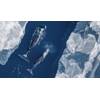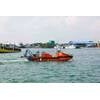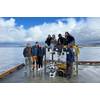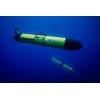Designer Ron Allum, Triton Submarines Seek Visionary
James Cameron’s film, “Deepsea Challenge 3D”, made its recent premier in cinemas worldwide. With the movie debut underway, Deepsea Challenger Chief Designer, Ron Allum and Triton Submarines, LLC have started working on the next ocean depth submersible, featuring a transparent pressure hull made of glass.
“As the film shows, Deepsea Challenger was very much a proof of concept vehicle,” says Allum. “The Triton 36000/3 takes us to the next stage, the world’s first commercially capable three-person submersible capable of diving to any place in the ocean, safely, reliably and repeatedly.”
The Triton 36000/3 cockpit will open and close like a clamshell, forming a transparent sphere. It will be controlled through a system of touch screen controls and information displays with commands communicated by radio or light signals through the glass hull. Temperature controls keep the interior comfortable, while the design keeps internal pressure stabilized at one atmosphere.
The Triton 36,000/3 is configured vertically to eliminate drag while diving and surfacing. As a result, it can dive to full ocean depth in just two hours and remain there for up to twelve hours before beginning its trip back to the surface. Allum believes the glass pressure hull will change our relationship with the deep ocean.
“Up until now, deep diving submersibles have always had small viewing ports, which give no real appreciation of the environment or the life around you. A glass hull equipped submersible will provide an entirely different viewing and sensory experience.”
Allum and Triton President, Patrick Lahey, met while working on Cameron’s expedition to film the deep-sea hydrothermal vents. They share an appreciation for the engineering and craftsmanship required to build deep diving manned submersibles.
“In the film, Deepsea Challenge 3D, Jim Cameron shows how advances made in materials technology and electronics have made it possible for a small, uniquely qualified and experienced company like Triton to build a submersible capable of safely exploring the deepest, most hostile and least understood part of the world’s ocean.”
Work on the Triton 36000/3 is gaining steady momentum. Materials and model testing are underway, with construction being the next step. Triton needs one last component: a customer who shares their vision.
“Deepsea Challenge 3D shows just how little we know about the deep trenches in our oceans,” Lahey said. “It’s crazy -we are searching the heavens for a planet with water yet we have never explored the water on our own world. We need more visionaries like Cameron to help us explore and better understand the most important ecosystem on our planet.”
Lahey and his team often dive to depths of 1,500 to 3,300 feet where they have made some amazing discoveries. “On almost every dive, we are seeing a part of the world no human being has ever seen before.” Among these discoveries was the first-ever live encounter with a giant squid in Ogasawara, Japan in 2012.














 February 2025
February 2025



